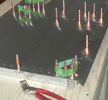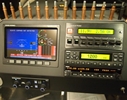


random user submitted photo
Ballistic Recovery System (Parachute)
Re: Ballistic Recovery System (Parachute)
I'm curious...how many G's are you guys pulling in your maneuvers. I would think at most it's just 2.5 or 3...I can't imagine you are anywhere near 4.5 which is only half the design load.
Frank Alvarez
Sonex #800, Aerovee 2.1
Scratch Building (working on Cowl)
Sonex #800, Aerovee 2.1
Scratch Building (working on Cowl)
- falvarez
- Posts: 143
- Joined: Wed Sep 28, 2011 2:30 pm
- Location: Middleburg, FL
Re: Ballistic Recovery System (Parachute)
I just put a G meter in and haven't done my typical routines with it yet. But coming out of a loop, I feel like its about 3 Gs. Video I've taken from the tail showed the wing skins flexing during rolls and spins so the wing is moving a bit. Another thing I've noticed is the paint on the bottom of the spar is popping loose indicating some stretching there.
John Gillis
SEL Private, Comm Glider, Tow pilot (Pawnee Driver)
Waiex N116YX, Jabiru 3300, Tail dragger,
First flight, 3/16/2013. 403 hours and climbing.
Home: CO15. KOSH x 5
Flying a B-Model Conversion (Super Bee Baby!)
-

fastj22 - Posts: 1594
- Joined: Sun Aug 21, 2011 5:56 pm
- Location: Mile High
Re: Ballistic Recovery System (Parachute)
Noel,
Great response! Couldn't have said it better.
-- Michael
XENOS #42; flying 3 years
OneX #169; ~ 2 months from first flight
Great response! Couldn't have said it better.
-- Michael
XENOS #42; flying 3 years
OneX #169; ~ 2 months from first flight
-- Michael
OneX N169XE
author of the 'Flight Data Viewer'
OneX N169XE
author of the 'Flight Data Viewer'
- XenosN42
- Posts: 421
- Joined: Thu Jul 24, 2014 4:45 pm
- Location: PA, USA
Re: Ballistic Recovery System (Parachute)
During steep turns, rolls, and wingovers you'll pull about 2 G's. Loops are best done by pulling until you reach 3 G's and then holding to complete the loop. Cubans are usually under 3, Reverse Cubans slightly less. The only time I see 4 G's is during some hard 90 degree bank turns, and then you feel that pretty good. Most everything else is done slower which helps keep the G load down. If I was worried about pulling more than 3 G's because the airframe wasn't up to the task, I'd choose another airframe because it's surprising easy to rack up the G's. Knowing the Sonex will go to 6 G without a problem takes all the worry out of breaking the airplane!
- sonex1374
- Posts: 605
- Joined: Thu Mar 27, 2014 1:02 am
Re: Ballistic Recovery System (Parachute)
It seems an aircraft needs to be designed around a BRS from the get go. Retrofitting one to a plane not designed for it is full of compromise and non-optimal features. Not to mention, could be downright deadly to the occupants if during the deployment, a cable crosses the cabin.
John Gillis
SEL Private, Comm Glider, Tow pilot (Pawnee Driver)
Waiex N116YX, Jabiru 3300, Tail dragger,
First flight, 3/16/2013. 403 hours and climbing.
Home: CO15. KOSH x 5
Flying a B-Model Conversion (Super Bee Baby!)
-

fastj22 - Posts: 1594
- Joined: Sun Aug 21, 2011 5:56 pm
- Location: Mile High
Re: Ballistic Recovery System (Parachute)
SonexN76ET wrote:The potential events I could envision using it would include: mid air collisions, air frame failures, control system jams or failures, partial or complete pilot incapacitation, engine failure over inhospitable terrain, a stall or spin that was unreoverable, inadvertent encounter with icing, or if an engine mount were to break
I understand the sentiment of this poster; and my next few comments are not intended to be aimed at him specifically; but I want to address this notion that a BRS is a "get out of jail free" card and provides for a safe landing... It absolutely does not.
It takes some completely-unsurvivable situations and makes them somewhat-less-unsurvivable. And for some cases it absolutely can save lives. But in many cases you need to think long and hard about whether it provides enough of an improvement to be worth the tradeoffs.
When you fire a BRS your aircraft will still descend at a fair rate - you're not falling at a feather's pace. The airframe and seats are expected to still absorb some impact-forces when the thing hits the ground.
And then once its on the ground, wind can drag the airframe. See the recent Cirrus ditching for reference. Note how the wake forms around the aircraft as its dragged along the water and eventually flips.
Now think about those two points and reference the earlier post about firing the BRS through the floor and landing upside down. Now imagine that happening on a rocky hillside, or a heavy forest. How long would the Sonex turtledeck and canopy protect the occupants? (Or any aircraft, really...)
Many of the failure-modes listed at the top of this message can be mitigated by:
- Flying Regularly [keeps corrosion down and helps keep lubrication spread across moving parts, as well as keeping the pilot from becoming rusty]
- Performing Good Pre-Flight Inspections [catch existing or impending problems before they happen in the air]
- Good Maintenance Practices [find small cracks before they become big ones; not every engine-mount tube is going to fail at the same time, for example]
- Being Mindful of your Weight & Balance [ensures that you don't get into unrecoverable stalls or spins]
- Don't Fly VFR into IMC or take stupid chances flying when the weather is crappy [avoids icing]
All of the above steps are cheaper and easier than engineering a BRS installation, paying for the BRS, and maintaining it over time. The steps above also don't require dead-weight to be carried in the airplane, reducing its useful load and increasing its stall-speed. They don't require extra pyrotechnics in close proximity to the airplane's occupants, either.
I'm not saying a BRS has no value; but often it is viewed as a panacea, or as a crutch that enables poor pilot proficiency or irresponsible/inattentive behavior.
We should think hard about items before we put them in our airplane, and understand the true value (and risk and cost) associated with them.
--Noel
- NWade
- Posts: 527
- Joined: Mon Aug 08, 2011 3:58 pm
Re: Ballistic Recovery System (Parachute)
I installed a BRS when I built my Zenith 701. I never did get my money's worth out of it as I never had any problems with the 701, however there are scenarios where the BRS would be a good last option (midair, airframe failure, etc) The BRS install in a Sonex would be more challenging. However, I am thinking about a seatpack type parachute instead of upholstery for the Onex I plan to build. I have not researched this much in terms of how comfortable this would be, (the cost is high, $2500 or so) but don't you need a parachute for aerobatics anyway? Part of the reason I put in the BRS and am looking at a seatpack parachute for the Onex is that I have personally known two very competent pilots who perished in situations where a parachute would have saved them. One had a midair in an RV during formation flight, the other had an improperly welded wing fitting fail in a Citabria during aerobatic instruction.
George Mueller
Onex Trigear
Rotax 912 ULS
Onex Trigear
Rotax 912 ULS
- gcm52
- Posts: 88
- Joined: Wed Feb 04, 2015 12:23 pm
Re: Ballistic Recovery System (Parachute)
gcm52 wrote:I have not researched this much in terms of how comfortable this would be, (the cost is high, $2500 or so) but don't you need a parachute for aerobatics anyway?
FWIW, glider/sailplane pilots often wear parachutes when we fly long cross-country flights (4-6 hours). Its an insurance policy that is simple to add and use, and costs almost nothing to maintain (keep it dry, and repack it twice a year for about $50 a pop). With a little lumbar support (i.e. a thin pad or towel between my lower back and the 'chute), I've never had any comfort issues; even on all-day flights.
The big difference in sailplanes is that we're usually sitting in a reclined/"lounge-chair" position - so we wear long/thin parachutes (like the Long Softie). However, there are many different models to choose from. Folks with really sensitive backs/backsides report that a sheepskin back-pad (an optional extra on most 'chutes) is a good investment for them.
Brand new parachutes do cost around $2500. But they last 15-20 years. You can often find previously-owned parachutes for around $1500 (these 'chutes not new and have fewer useful years remaining, but are not actually "used"/deployed).
Fly safe,
--Noel
- NWade
- Posts: 527
- Joined: Mon Aug 08, 2011 3:58 pm
Re: Ballistic Recovery System (Parachute)
I bought a National Flat Pack 2 years ago for about $1800 from ACS. Costs me $35 every 6 months to repack if I want to stay legal. I loan it to anyone who wants it for whatever they might be doing.
I remove the upholstery when I wear the pack. I only wear it when doing aerobatics, solo. I don't do aerobatics with a passenger. I'm not required to wear it, but it gives me comfort knowing I can bail out. My wife supports it.
I remove the upholstery when I wear the pack. I only wear it when doing aerobatics, solo. I don't do aerobatics with a passenger. I'm not required to wear it, but it gives me comfort knowing I can bail out. My wife supports it.
John Gillis
SEL Private, Comm Glider, Tow pilot (Pawnee Driver)
Waiex N116YX, Jabiru 3300, Tail dragger,
First flight, 3/16/2013. 403 hours and climbing.
Home: CO15. KOSH x 5
Flying a B-Model Conversion (Super Bee Baby!)
-

fastj22 - Posts: 1594
- Joined: Sun Aug 21, 2011 5:56 pm
- Location: Mile High
Re: Ballistic Recovery System (Parachute)
To answer Frank's question; I second the 3 Gs as normal. I frequently see 3.5, but have recorded 4.5 on a few occasions. I did see 6.5 recorded once, but it was due to clear air turbulence. Took the fun right out of the flight. An inspection of the airframe on landing revealed nothing (short of a brown stain in my underwear). Under normal circumstances loops and such I never see any movement of the wings. I did a lot of loops looking at the wing while trying to catch a "just so" picture. Finally got it (close anyway):
Rob,
N157SX
Rob,
N157SX
-

rbarber - Posts: 107
- Joined: Sat Mar 10, 2012 5:47 pm
Who is online
Users browsing this forum: Google Adsense [Bot] and 11 guests







